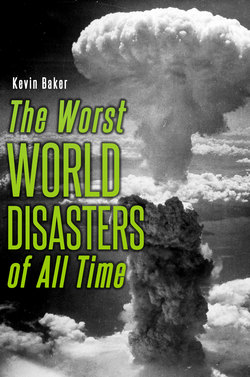Читать книгу The Worst World Disasters of All Time - Kevin Baker - Страница 8
6 – Spanish Flu Pandemic
ОглавлениеSeattle policemen wearing masks provided by the Red Cross.
Date: January 1918 – December 1920.
Location: Worldwide.
Disaster Type: Influenza pandemic.
Fatalities: 500 million people infected and 20 - 40 million deaths worldwide
The 2009 the H1N1 flu pandemic was a worldwide concern where the so-called ‘bird flu’ mutated to affect some human beings in several regions of the world. But this was the second time that the H1N1 virus threatened human life. Back in 1918, the very first bird flu pandemic caused much more devastation and death. Back then, there was no vaccine and very few medications that could be used to combat this disease, and in all over 500 million people were infected around the globe, from the Pacific Islands all the way to the Arctic, with a death rate close to 20%. Almost 5% of the world’s population perished in a matter of months due to the Spanish flu. While most countries were hit, there were some very large populations decimated in Spain, which is how the pandemic came to be known as the Spanish flu.
World War I and the way soldiers were being deployed to faraway locations, plus their living conditions, were the primary causes of why this particular pandemic was so devastating. Because of the war, soldiers were present in large numbers, and would all sleep together in large tents or buildings. The close quarters that were common to soldiers in those days increased the infection rate, on top of massive troop movements which allowed the flu to spread around the world much faster than it otherwise could have. There were other reasons why the war helped the virus out too, like malnourishment and exhaustion due to intense and stressful combat. Both sides in the conflict were hit, but the Axis side suffered many more casualties, which may actually have helped contribute to the Allies eventual victory in World War 1.
There is no record showing where the flu came from, but in January of 1918 U.S. Army doctors noticed the sickness in Kansas. The virus quickly spread around the base and to surrounding areas. By March, it had made its way to New York and the east coast. Like the 2009 pandemic, H1N1 came from birds, but in the case of the 1918 event, historians think that the virus first mutated to pigs which were kept in large quantities near soldiers as cheap sources of food. The origins were almost certainly somewhere in Europe, possibly France, and soldiers were the main carriers of the disease, spreading it around to the local population.
20 - 40 million people were killed in less than two years by the Spanish flu pandemic, which comes close to the Black Death’s fatality count, making it one of the most deadly diseases in history. While a lot of infants and elderly people were killed, as is the case for most diseases, in this case there were also a lot of 15 to 35 year olds included in the death toll, because soldiers were the main ones to carry the disease from one place to the next and generally would be in this age group. It is believed that India suffered the most deaths with a fatality count of 17 million people. The disease ended very abruptly by the end of 1918, where cases rapidly disappeared, as doctors became better at treating the disease. Some historians also think that the virus mutated to a less deadly variant at that time as well.
